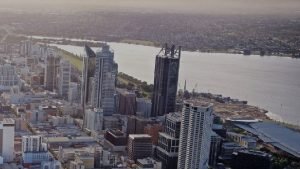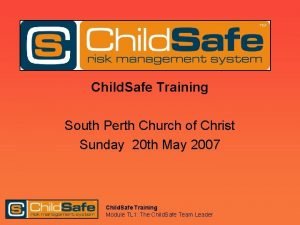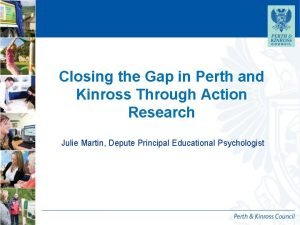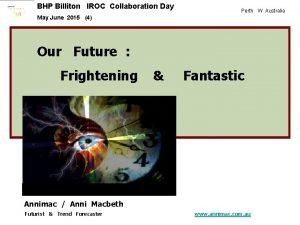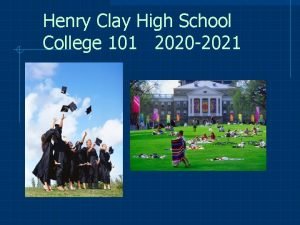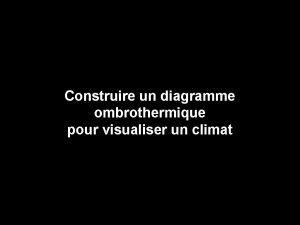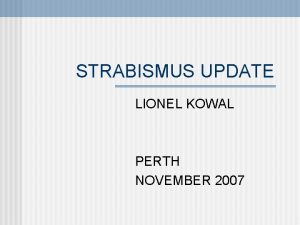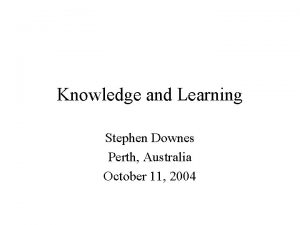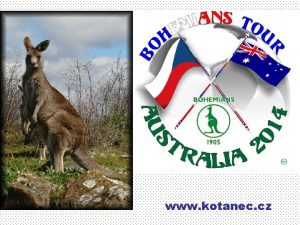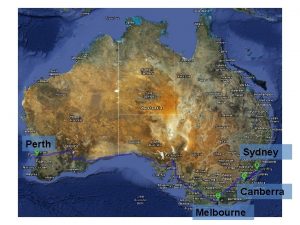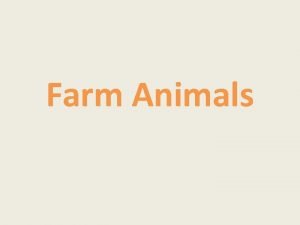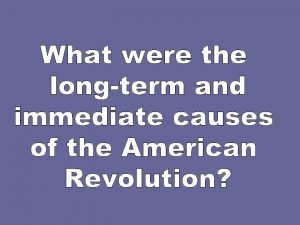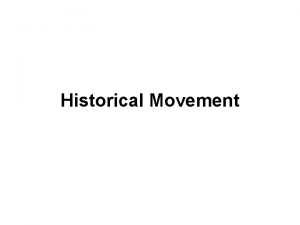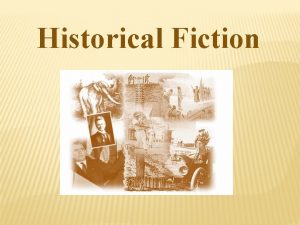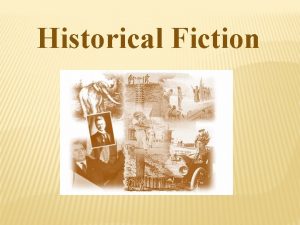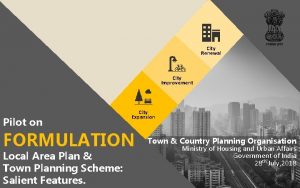Perth City Farm Historical Display This historical display

















- Slides: 17

Perth - City Farm: Historical Display This historical display is set out within a chronological order, indicting the historical processes Perth - City Farm, a not for profit - community garden / youth organization and how it has been situated upon its present location. It also incorporates many other past, historical activities / processes that have been situated upon the Perth - City Farm precinct. Done By: Peter, N, Evans (BA - Sus – Dev / History) Date: 11/12/2014 Email admin@echocredits. com. au

Pre modern – 1800 Australian Aboriginal - Occupation of area: Indigenous Australian - aboriginal people’s occupation of the Perth - City Farm area dates back to thousands of years before any European settlement of the area. In fact around the time of European settlement of Perth in 1829, there were around 3, 000 indigenous / aboriginal peoples living within the Swan River region. The indigenous tribal group, which inhabited the area where City Farm is now located, were the Boorloo tribal group. This tribal group was also connected, with Noongar / Whadjuk tribal territory area, which encompassed all of the Swan / Canning river region. The Boorloo tribal group, inhabited Mooro traditional lands, as is indicated in diagram 1. Mooro / Boorloo tribal lands, right up to the early 1800 s, had interconnecting swamps / lakes on the Swan Coastal plain region, as indicated in diagram 2. In fact for all Noongar / Whadjuk peoples, these interconnecting swamps / lakes on the Swan Coastal plain, were sacred and created by the “Waggle” spirit ancestor. All these interconnecting swamps / lakes, were also a food source, for all the Noongar / Whadjuk peoples, as fish, turtles, shellfish and bird life, etc. , were located within these interconnected swamps and lakes. The Perth - City Farm area, at this time, was located on / or near one of these swamps / lakes, named by Europeans at the time, as Tea Tree lake or the latter named, Claisebrook stream / drain. While also between 1927 - 1954, as the central city - Perth region, was a prohibited area for indigenous / aboriginal Australians, many aboriginal peoples, inhabited the area around Perth - City Farm, as this area was just outside the boundary, of cities prohibited area for indigenous / aboriginal Australians.

1870 – 1880 Mulberry Farms: Between the dates of 1870 -1880, four thousand mulberry trees were planted within the Carisbrook area, this totalled a land mass of around 16 acres / 6 hectares of mulberry trees planted within the Carisbrook area. Mulberry trees were used in the late 19 th century for a variety of reasons including, for stock and breeding grounds for silk worms, so that they could produce silk thread, attain the mulberry for food, medicinal purposes and for furniture, etc. It is therefore feasible to assume that of this mass mulberry tree planting process, some of Perth - City Farm area / property was incorporated within this early mulberry tree planting process. Indeed at present, the Perth - City Farm area / property, has an old established mulberry tree planted within its outside garden area. In fact, as mulberry trees can grow to be over 170 years old, * it is also feasible to assume that this mulberry tree within Perth - City Farm area / property, could have been planted within the early 1870 s mulberry tree planting process, it would thus make, this mulberry tree within Perth - City Farm, outside garden area, around 145 years old.

1883 – 1900 Vacant Land on Site: The above picture displays the area surrounding City Farm in the early 1800 s, in the top left of the picture, is the formation of the West Australian Cricket ground (WACCA), while in the middle right of the picture, where the swamp / lakes are, this is the Clasiebrook area. Consequently further to the left of this swamp / lakes area, would have been where City Farm could have been located. As a result, as can be seen by the above picture, much of the land near City Farm, in the early 1800 s, was vacant land, untouched by civilisation, at this time. The map diagram on the left indicates the Perth - City Farm area, circa early 1900 s, to the left of Kirkstall Gardens / Terrace, is the area where Perth - City Farm now is situated. As can be seen from this map diagram, there seems to be maybe 4 / 5 dwellings on this area, in the early 1900 s. However it is not indicated, weather these buildings / dwellings are either horse stables, workshops / sheds or homes. Though the dwelling diagram in the bottom right hand corner, is marked as a workshop /shed. Indeed in the early 1900 s, there were quite a few workshops / sheds and horse stables within this area. Thus it is possible that all these buildings / dwellings, to the left of Kirkstall Gardens are either workshops / sheds or horse stables. As a result its possible to assume, that this area to the left of Kirkstall Gardens was in essence semi vacant land, used for industrial or commercial purposes only. Indeed from the early 1900 s to the 1970 s, all of the City Farm area, was zoned by the city of Perth as a non-residential area, to be used for, either industrial or commercial purposes only.

1901 – 1913 Agriculture Auctions / Machinery Sale Yard: Between the dates of 1901 -1913 the Perth - City Farm area was used as a facility to store and sell used agriculture / farm equipment, by the propitiator F, A, Mansfield - pty ltd. The agriculture / farm equipment, was predominantly sold by a non-reserved auction process. Much of the agriculture / farm equipment auctioned, consisted of ploughs, drills, scarifiers, paints, brushes and scrap iron / metal, etc. It has to be noted however, that agriculture / farm machinery auctions were not the only auctions that were conducted within this area, at the time. For in the early 1900 s a Mr: Chas Somnmers, auctioned some homes within the Perth - City Farm area, or at Kirkstall terrace / East Perth. (As the area was known in the early - 1900 s).

1920 – 1925 Kingia Fibre Company: The Kingia Fibre Company was situated on the now present Perth - City Farm area, between the dates of 1920 -1925. The Kingia Fibre Company was owned and run by, Mr - D. Bedligton of Collie, who leased the specific land of the West Australian Government. The Kingia Fibre Company / factory made paper, corks, cricket balls, life buoys and alcohol, from the inside – stem pith of the Kingia grass tree (Blackboy). While the long thin leaf like structures, at the top of a Kingia Grass Tree, (Blackboy), were bound to the end of timber shafts, to make hardy brooms / broom heads. Unfortunately the Kingia Fibre Company, ceased to operate on Tuesday 22 nd January 1923, when a fire completely destroyed the factory premises. (Sadly the Fire brigade, did not seem to have enough water pressure, to fight the fire effectively). The fire was presumably started, by fireworks igniting some Kingia grass tree debris, on the outside of the factory.

1930 - 1969 Vacuum / Mobil Oil Company: Between the dates of 1930 – 1969 the Vacuum / Mobil oil Company was located on the now present Perth - City Farm area. The Vacuum / Mobil oil Company, at these premises, was in the business of distributing oil and fuel products, for Gargoyle Mobiloil and Plume Motor Spirits and of suppling other well-known oil and fuel products, including a variety of oil lubricants and greases, etc. The Vacuum / Mobil oil Company owned the land in question and in 1930 it redeveloped the land at cost of more than $5, 000. For as indicted in picture 1 on the left, it can be seen that there was to be quite some redevelopment that was necessary, before Perth - City Farm area could be used as an oil / petroleum storage depot and distribution yard. Indeed in picture 2 on the left, it shows the property redevelopment process finished and in use as the Vacuum / Plume / Mobil - oil / petroleum storage depot and distribution yard. However, due to a business downturn in 1969/70, the Vacuum / Plume / Mobil - Oil Company, decided to sell its Kirkstall Terrace / Gardens property to the West Australian Government. Yet as can been seen in picture 2 on the left, in its prime, the Vacuum / Mobil oil Company had six vehicle garage located at this property. This indicated in picture 2, is where the big building in the background of the photo is located. This big building in the background of the photo, is where Perth - City Farm administrative offices / big hall are situated at present. While in the centre of picture 2, is the filling station for the petroleum / oil road tankers. This area can still be envisioned within centre of City Farm, at present. Moreover according to Picture 2 on the left, at the rear of the lubricant and case lot storage building, on the right hand side of picture 2, there was an underground storage facility, which stored and pumped oil / fuel into the centre filling station, for the petroleum / oil tankers.

1900 – 1960 s (Overall) Low Income Area: Unfortunately the area where Perth - City Farm is now located has not always had a good reputation. For within the 1900 s and right up until the 1980 s, the area had been recognised as an area where poverty and low income families were situated. This probably came about, due to the fact that this specific area, was just on the outskirts of the central city area and had many warehouses, workshops, horse stables and factories located within the area. In fact many of the people / occupants living within the area probably worked in, many of the warehouses, factories, horse stables and workshops etc. , within the area. Thus many of the dwellings / homes within the area, at the time, may have reflected a poverty projection to many. Indeed this sort of poverty projection of the Perth - City Farm area may been envisioned by many right up to the mid-1980 s, as indicted in the above photo of a derelict building in Kirkstall Terrace / Gardens. The fact that there had been some interesting characters living within the area in the early 1900 s, which probably contributed to an unsavoury reputation of the area. For instance, there was a character my name of Mahomet Ali, who in the early 1900 s, lived in a house in Kirkstall Terrace and who seemed to get on the wrong side of the law, at times. Also, with the Perth - City Farm area having had 4 fires in an early 35 year period, (as indicated in the pics to the right), this may not have helped to alleviate many concerns, that the area was not safe. However not all the people living within the Perth - City Farm area were of an unsavoury character. For instance, there were 2 young men who signed up to fight in WW 1, one by the name of Frank Smyth, who in 1917, lived at 1 Kirkstall Gardens and survived the war and another by the name of E, B, Lowe, who in 1916, lived at 2 Kirkstall Gardens and who sadly died in this war. On the other hand some residents of the area seemed to be very lucky, such as in the case of Mrs Loraine Clark, of 2 Kirkstall Terrace who in 1949, won $3, 000 pounds in a West Australian charity / lottery.

1970 – 1990 Government (Westrail) Railway Yard: In between the dates of 1968 – 1972, the West Australian Government Railways, (Westrail), brought the area of land on which Perth - City Farm now is situated, as indicated in the picture on the right. (The land area on the diagram, which is coloured in red). This area of land, as indicted, was freehold land at the time and was owned by Vacuum / Mobil Oil Company. The area of land was thus subsequently purchased off the Vacuum / Mobil Oil Company, in August 1968, by the West Australian Government Railways, at a cost of $8, 100. However the land indicated, was not being used for any real significant purposes, at the time. Though it was occupied and used by a business called; Frank Manford Pty Ltd, and its Forklift and Pallet Hiring Division. (The Frank Manford Pty Ltd business, was within the logistics and transport industries). The West Australian Government Railways, (Westrail), occupied and used the area of land, as indicted in the picture on the left, up until 1990. (This area of land which is coloured red, as indicted on the left, is where Perth - City Farm is now situated). In fact this area of land, between the dates of 1970 – 1990, was predominantly used by West Australian Government Railways, (Westrail), as a lockable storage yard, for some of their Westrail buses and for other West Australian Government The above pic, (area coloured red), is a diagram showing the area of land that was purchased by West Australian Government Railways / Westrail, in 1968 – 1970 of the Vacuum / Mobil Oil Company. Railways logistics purposes, etc.

1990 – 2014 1 - City Farm - Started on Area: Perth City Farm was first conceived in 1990 by Joanne Tucker, Rosanne Scott, and Clayton Chipper and at this early stage it was called ‘Children of the Trees, ” in reference to the project intending to instruct children / young adults on bush rehabilitation processes. It was also in reference to the parent organization “Men of the Trees” native plant nursery - youth oriented (MOTT) program goals, which were to support the “Children of the Trees / Perth - City Farm project” and help get it started. As a result in 1994 Rosanne Scott, Chris Ferreira, Neal Bodel, Clayton Chipper and Amanda Dent, started a youth project called: Plantery Action Group, (PAN), with the idea to help children / youths improve their wellbeing and to help them rehabilitate themselves, via a community gardening and permaculture processes, engaged upon a heavily degraded industrial site. Consequentially a heavily degraded industrial site had to be found and it was, as the East Perth Redevelopment Authority (EPRA) offered (PAN), a barren and degraded site near the Claisebrook train station. At the time, the site was offered to (PAN) on a two year lease, as it was scheduled to be demolished in 1996, to make way for additional car-parking space. In the first few months of Perth - City Farm operating, in early 1995, many of the buildings had to be renovated, as lot of them had asbestos roofs, etc. While all the scrap metal had to be removed and all the contaminants within the soil had to be cleared. (As indicted in above picture). For example, all the oil, grease, lead and cadmium toxins within the soil had to be removed, as they were all left from previous property dwellers in the area.

1990 – 2014 2 - City Farm - Established on Area: As Perth - City Farm, right from the very beginning, has been a not-for-profit, volunteer-based organisation, it has had to rely upon financial grants to initiate and implement many of its programs / projects. In fact in 1995, Perth - City Farm got its first government / federally funded project, the "Landcare and Environmental Action, (LEAP), Program, which enabled City Farm to help young unemployed people undertake training and work on local environmental and cultural projects. And in City Farms case, this helped them to teach youths about bush rehabilitation, permaculture, and plant nursery techniques and to participate in some specific cultural projects, etc. In addition over the years, Perth - City Farm has facilitated and run many other environmental, cultural and community orientated projects / events at its location. Such as, community arts projects, ongoing multicultural markets, a 2011 Creative Connections art exhibition, etc. While it has provided overseas and local artists, musicians with the space to present exhibitions / workshops. Such as, the buskers festival in may-2005, drumming workshops for the Sambanistas since 2000 and performances by the Burundian peace choir. Also since 1998 City Farm facilitated and run Australian government ‘Work-for-the-Dole' programs and has provided community Service programs for the WA Justice Department and volunteering opportunities for intellectually disabled individuals. While From 1995 onwards City Farm has continued to offer permaculture and other assorted educational courses, onsite / offsite and via Polytechnic West, Central Institute of Technology - Tafes. Offsite, Perth - City Farm has been involved in a number of bush rehabilitation projects around the State, including the 1990 s - Pia -tree-planting project, which is located on Wadjarri aboriginals people's lands, around 720 km north-east of Perth. “While onsite since 1994, approximately 4, 000 m 3 of tree mulch, 1, 500 m 3 of lawn clippings and 20 tonnes of newspaper have gone into City Farm's gardens. Whilst everything that can be recycled is reused in its offices and in arts projects. “p. 6. (Stange, 2003, p. 6). Indeed there are many projects Perth - City Farm has been involved with, which have been featured in local, state and national newspapers, magazines. Including, “Horticulture Australia, Spice, airline inflight magazine, The West Australian magazine, and cited in the WA State Sustainability Strategy. As well as being aired on local community, state and national television programs, including Landline, Gardening Australia and the Garden Gurus’ Gardening WA program. City Farm was also featured at the Western Australian Museum, as a model community for the future. ” p. 5(Men of the Trees, 2009, p. 5). In fact for the last 20 years City Farm has partnered with many Western Australia community, private and government organisations, in its effort to improve the environment and wellbeing of children and youth in the Perth community, including BHP Billiton, Mission Australia, Oxfam, Polytechnic West, Central Institute of Technology, St Bartholomew’s House, UWA and Volunteering WA, to name a few.

1990 – 2014 3 - City Farm – Evolving on Area: Of course, all of Perth - City Farm programs / projects over the years, have had the enduring legacy of being guided in their development by Perth - City Farm original (PAN) gaols and visions; Of helping children / youths improve their wellbeing and instructing youths on how to rehabilitate themselves, via community gardening and permaculture processes etc. , as indicted in diagram 1. However it has not been all plain sailing for City Farm, as it has had its problems. For example as indicated diagram 2, in early January 2000, Perth - City Farm was threatened with eviction from its present site, by the (EPRA), as it wished to use the land for other development purposes. In fact some may imply, as indicted in the above example, that city farms / community gardens in general, may create tensions / concerns about green / public spaces within an urban environment and that because of this, community gardens / city farms like Perth - City Farm, may not be offered an assured space / place within a community. However as has been illustrated thought out this display, if there is one thing that describes a place, it is that change is continual and that resilience is the antidote for a place to be remembered in history. Hence as Perth - City Farm overcame the above issue and many others, with a communities support, etc. It has thus confirmed that all spaces / places are in need of resilient, respectful and sustainability paths, such as Perth - City Farm. As a result Perth - City Farm has proceeded into the future anew and some of City Farm past / present success stories have been: “ The Pia -tree-planting project since 1990 s, which is located on Wadjarri people's lands: Delivering Horticultural Therapy since 1994 to clients of Mental Health, Disability Services and the Ministry of Justice: Running Work for the Dole programs from 1998, resulting in close to a thousand people learning and practicing sustainable community principles: Since 2000 City farm has reached the “in Conversion” level of Organic Certification for our gardens, nursery and poultry areas: Won the 2001 State Recycling Award for a Community Group for demonstrating eleven years of recycling education and practice: Opening the plant Nursery to the public since 2005: Established an Organic Growers Market selling Certified Organic & Biodynamic products. The market has operated every Saturday since 2005: Commencement of the School Kitchen Garden's project in 2007: Presenting annual free community festivals from Perth - City Farm site: The area were Perth - City Farm is now located, has now been renamed City Farm Place, by the Western Australian State Government. ” pp. 5 -6 (Men of the Trees, 2009, pp. 5 -6). As Perth - City Farm has evolved into the present, it has reinforced its relationship with its parent organisation Men of the Trees and formed an ongoing partnership with the not-for-profit organisation - Green World Revolution (GWR), who manage the everyday running operations of Perth - City Farm. Indeed in recognition of Perth - City Farm commitment in enhancing the future wellbeing of Perth’s environment and youth, since 2004, it has been granted a 40 year land tenure at its present location, by the Western Australian - State Government.





 Perth hub city link
Perth hub city link Smart recovery brisbane
Smart recovery brisbane Perth amboy high school main campus
Perth amboy high school main campus Core trays
Core trays Jennmar australia
Jennmar australia South perth church of christ
South perth church of christ The gap perth
The gap perth Curtis lumber schroon lake ny
Curtis lumber schroon lake ny Bhp iroc
Bhp iroc Henry clay high school graduation 2021
Henry clay high school graduation 2021 Climograma perth
Climograma perth Infinite campus turner
Infinite campus turner Construire un diagramme ombrothermique
Construire un diagramme ombrothermique Ikea perth
Ikea perth Antimicrobial stethoscope covers
Antimicrobial stethoscope covers Squint surgery perth
Squint surgery perth Sandbox perth
Sandbox perth Knowledge society perth
Knowledge society perth
